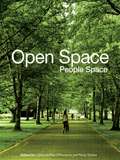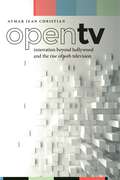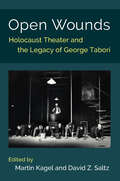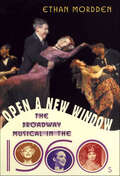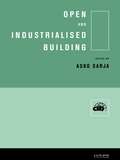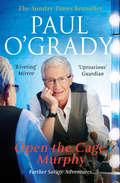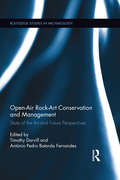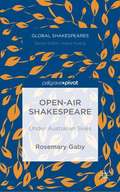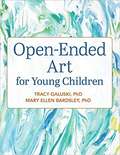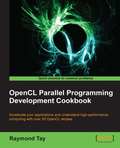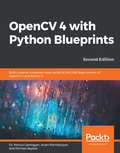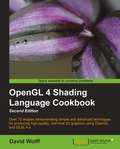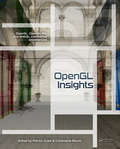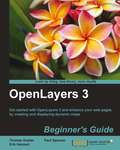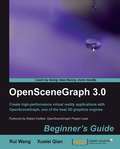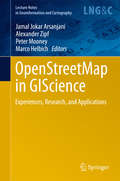- Table View
- List View
Open Space: Open Space: People Space 2
by Catharine Ward Thompson Penny TravlouHighly visual and containing contributions from leading names in landscape, architecture and design, this volume provides a rare insight into people’s engagement with the outdoor environment; looking at the ways in which the design of spaces and places meets people’s needs and desires in the twenty-first century. Embracing issues of social inclusion, recreation, and environmental quality, the editors explore innovative ways to develop an understanding of how the landscape, urban or rural, can contribute to health and quality of life. Open Space: People Space examines the nature and value of people’s access to outdoor environments. Led by Edinburgh’s OPENspace research centre, the debate focuses on current research to support good design for open space and brings expertise from a range of disciplines to look at: an analysis of policy and planning issues and challenges understanding the nature and experience of exclusion the development of evidence-based inclusive design innovative research approaches which focus on people’s access to open space and the implications of that experience. Invaluable to policy makers, researchers, urban designers, landscape architects, planners, managers and students, it is also essential reading for those working in child development, health care and community development.
Open TV: Innovation beyond Hollywood and the Rise of Web Television (Postmillennial Pop #20)
by Aymar Jean ChristianHow the internet transformed television Before HBO’s hit show Insecure, Issa Rae’s comedy about being a nerdy black woman debuted as a YouTube web series The Misadventures of Awkward Black Girl, her response to the absence of diverse black characters on the small screen. Broad City, a feminist sitcom now on Comedy Central, originated as a web series on YouTube, developed directly out of funny women Ilana Glazer and Abbi Jacobson’s real-life friendship. These unconventional stories took advantage of the freedom afforded outside the traditional television system: online. Open TV shows how we have left “the network era” far behind and entered the networked era, with the web opening up new possibilities for independent producers, entrepreneurs, and media audiences. Based on interviews with writers, producers, show-runners, and network executives, visits to festivals and award shows, and the experience of producing his own series, Aymar Jean Christian argues that the web brought innovation to television by opening up series development to new producers, fans, and sponsors that had previously been excluded. Online access to distribution provides creative freedom for indie producers, allows for more diverse storytelling from marginalized communities, and introduces new ways of releasing and awarding shows. Open TV is essential reading for anyone interested in the changing environment of television and how the internet can inspire alternatives to what’s on TV tonight.
Open Water
by Nelson Caleb AzumahTwo young people meet at a pub in South East London. Both are Black British, both won scholarships to private schools where they struggled to belong, both are now artists - he a photographer, she a dancer - trying to make their mark in a city that by turns celebrates and rejects them. Tentatively, tenderly, they fall in love. But two people who seem destined to be together can still be torn apart by fear and violence.
Open Wounds: Holocaust Theater and the Legacy of George Tabori
by David Z. Saltz Martin KagelThis volume collects original essays on Hungarian-German playwright and screenwriter George Tabori (1914–2007) and his remarkable contributions to the stage. Tabori, a Jewish refugee and a truly transnational author, was best known for his work in New York theater that irreverently explored the Jewish experience, particularly the Holocaust. Although his illustrious career spanned a century, two continents, several languages, and a variety of literary genres, Tabori’s work has received scant attention in American letters, in spite of its significance for U.S. theater and Holocaust studies. Until Tabori, most dramas about the Holocaust were either rooted in American domestic realism, striving to create a strong empathetic connection between the audience and Holocaust victims, or featured an unembellished documentary style. Tabori staked out a third position, beyond realism and documentation. The volume brings together the voices of international scholars to provide a comprehensive introduction to Tabori’s theater as well as in-depth analyses of his work, discussing all of his major plays. Individual essays address Tabori’s postdramatic theater in relation to sacrificial ritual, performance studies, and post-humanist approaches to the contemporary stage, as well as performance aspects of his productions, questions of ethics and aesthetics raised by his theater, and his plays’ relation to Holocaust representation in popular culture.
Open Wounds: Holocaust Theater and the Legacy of George Tabori
by David Z. Saltz Martin KagelThis volume collects original essays on Hungarian-German playwright and screenwriter George Tabori (1914–2007) and his remarkable contributions to the stage. Tabori, a Jewish refugee and a truly transnational author, was best known for his work in New York theater that irreverently explored the Jewish experience, particularly the Holocaust. Although his illustrious career spanned a century, two continents, several languages, and a variety of literary genres, Tabori’s work has received scant attention in American letters, in spite of its significance for U.S. theater and Holocaust studies. Until Tabori, most dramas about the Holocaust were either rooted in American domestic realism, striving to create a strong empathetic connection between the audience and Holocaust victims, or featured an unembellished documentary style. Tabori staked out a third position, beyond realism and documentation. The volume brings together the voices of international scholars to provide a comprehensive introduction to Tabori’s theater as well as in-depth analyses of his work, discussing all of his major plays. Individual essays address Tabori’s postdramatic theater in relation to sacrificial ritual, performance studies, and post-humanist approaches to the contemporary stage, as well as performance aspects of his productions, questions of ethics and aesthetics raised by his theater, and his plays’ relation to Holocaust representation in popular culture.
Open a New Window: The Broadway Musical in the 1960s (The History of the Broadway Musical)
by Ethan MorddenIn the 1960s, the Broadway musical was revolutionized from an entertainment characterized by sentimental standards, such as Camelot and Hello, Dolly!, to one of brilliant and bittersweet masterpieces, such as Cabaret and Fiddler on the Roof. In Open a New Window, Ethan Mordden continues his history of the Broadway musical with the decade that bridged the gap between the romantic, fanciful entertainments of the fifties, such as Call Me, Madam, to the seventies when sophisticated fare, such as A Little Night Music and Follies, was commonplace. Here in brilliant detail is the decade and the people that forever transformed the Broadway muscial.
Open and Industrialised Building
by Asko SarjaThere is clearly potential for the industrial production of open buildings, buildings where the parts which are designed to allow a high degree of freedom for layout, construction and adaptation. Industrialized open building has the potential to radically cut building costs and construction time.This book focuses on product and production systematics and information systematics, and begins with an extensive survey of the field by the editor. The second part consists of a series of descriptions of the experience of different countries, and chapters on particular themes. The book presents new material developed from Commission W24 of the CIB (the International Council for Building Research Studies and Documentation).
Open the Cage, Murphy!: Hilarious tales of the rise of Lily Savage
by Paul O'GradyTHE SUNDAY TIMES BESTSELLER'With typical razor-sharp wit and candour, Paul tells of his rise to fame as Lily Savage . . . Riveting.' Daily MirrorFrom Britain's most beloved TV star, Open the Cage, Murphy is an action-packed roller-coaster ride through a decade of Paul O'Grady's life, stuffed full to the gunwales with hilarious stories, extreme situations and outrageous one-liners.A must read for any Paul O'Grady fan, Open the Cage, Murphy follows his brilliant comic creation Lily Savage as she embraces success and world domination beckons.From being involved in a plane crash, to getting caught up in the LA riots and a close encounter with Madonna, the stories come thick and fast. Paul takes us with him to a gay-themed weekend in Butlin's in Skegness, on a rowdy tour with Prisoner Cell Block H - the Musical and into the depths of the Australian rainforest, where he befriends a rare bird that can disembowel a man with a single kick. The dramatis personae include a family of dolphins, Charlton Heston and the ghost of Joan of Arc - and there's a starring role for a certain remarkable dog, Buster Elvis Savage.But whether he's writing about star-studded Hollywood parties, the devastating loss of close friends to AIDS, or late night shenanigans at the end of Blackpool Pier, Paul's wit and humanity never desert him.Open the Cage, Murphy is a genuine delight - all the more so for being delightfully genuine.Readers love Open the Cage, Murphy!'I couldn't put it down . . . Paul comes across as a very intelligent man . . . with a heart of gold under that naughty exterior.' *****'This is such a great read, Paul is excellent when describing things makes you feel as though you are there with him. His humour warmth and caring comes out in abundance.' *****'An excellent read. He takes you through the highs and lows of his life, you laugh and cry with him.' *****
Open-Air Rock-Art Conservation and Management: State of the Art and Future Perspectives (Routledge Studies in Archaeology #12)
by Timothy Darvill António Pedro Batarda FernandesWhile much has been achieved in understanding and managing weather effects and erosion phenomena affecting ancient imagery within the relatively protected environments of caves and rock-shelters, the same cannot be said of rock-art panels situated in the open-air. Despite the fact that the number of known sites has risen dramatically in recent decades there are few examples in which the weathering and erosion dynamics are under investigation with a view to developing proposals to mitigate the impact of natural and cultural processes. Most of the work being done in different parts of the world appears to be ad-hoc, with minimal communication on such matters between teams and with the wider archaeological community. This richly illustrated book evaluates rock-art conservation in an holistic way, bringing together researchers from across the world to share experiences of work in progress or recently completed. The chapters focus on a series of key themes: documentation projects and resource assessments; the identification and impact assessment of weathering/erosion processes at work in open-air rock-art sites; the practicalities of potential or implemented conservation interventions; experimentation and monitoring programs; and general management issues connected with public presentation and the demands of ongoing research investigations. Consideration is given to the conservation of open-air rock-art imagery from many periods and cultural traditions across the Old and New Worlds. This timely volume will be of interest to conservators, managers, and researchers dealing with aesthetic and ethical issues as well as technical and practical matters regarding the conservation of open-air rock-art sites.
Open-Air Shakespeare: Under Australian Skies
by Rosemary GabyMany people today first encounter staged Shakespeare in an open-air setting. This book traces the history of open-air Shakespeares in Australia to investigate why the anomaly of adapting 400-year old plays under Australian skies exerts such a strong appeal.
Open-Ended Art for Young Children: Moving Beyond the Basics
by Tracy Galuski Mary Ellen BardsleyOpen-ended art is defined as art activity where children are free to use their imagination as they explore a variety of materials without a planned outcome. When teachers embrace open-ended art, they emphasize the process of creating and observe the developmental growth being experienced by the children. Open-ended art provides children an important opportunity to think about, feel, and express ideas. It allows teachers to slow down the pace of the day and appreciate the beauty that comes from simple experimentation with art materials. <p><p> There are many books available to educators that include art ideas and projects, but Open-Ended Art for Young Children goes beyond the basics to highlight why the field of early childhood education advocates for open-ended art and explains how to adapt to new ways of thinking about art. Authors Dr. Tracy Galuski and Dr. Mary Ellen Bardsley present, chapter by chapter, the challenges teachers encounter when faced with best practices and expectations related art process and product. Each chapter begins with a classroom vignette that describes the challenge, followed by a plethora of solutions grounded in research and illustrated through practical examples. Each chapter includes full-color pictures and photos and ends with an activity or investigation for reflection.
OpenCL Parallel Programming Development Cookbook
by Raymond TayOpenCL Parallel Programming Development Cookbook will provide a set of advanced recipes that can be utilized to optimize existing code. This book is therefore ideal for experienced developers with a working knowledge of C/C++ and OpenCL.This book is intended for software developers who have often wondered what to do with that newly bought CPU or GPU they bought other than using it for playing computer games; this book is also for developers who have a working knowledge of C/C++ and who want to learn how to write parallel programs in OpenCL so that life isn't too boring.
OpenCV 4 with Python Blueprints: Build creative computer vision projects with the latest version of OpenCV 4 and Python 3, 2nd Edition
by Michael Beyeler Dr. Menua Gevorgyan Arsen MamikonyanGet to grips with traditional computer vision algorithms and deep learning approaches, and build real-world applications with OpenCV and other machine learning frameworks Key Features Understand how to capture high-quality image data, detect and track objects, and process the actions of animals or humans Implement your learning in different areas of computer vision Explore advanced concepts in OpenCV such as machine learning, artificial neural network, and augmented reality Book Description OpenCV is a native cross-platform C++ library for computer vision, machine learning, and image processing. It is increasingly being adopted in Python for development. This book will get you hands-on with a wide range of intermediate to advanced projects using the latest version of the framework and language, OpenCV 4 and Python 3.8, instead of only covering the core concepts of OpenCV in theoretical lessons. This updated second edition will guide you through working on independent hands-on projects that focus on essential OpenCV concepts such as image processing, object detection, image manipulation, object tracking, and 3D scene reconstruction, in addition to statistical learning and neural networks. You'll begin with concepts such as image filters, Kinect depth sensor, and feature matching. As you advance, you'll not only get hands-on with reconstructing and visualizing a scene in 3D but also learn to track visually salient objects. The book will help you further build on your skills by demonstrating how to recognize traffic signs and emotions on faces. Later, you'll understand how to align images, and detect and track objects using neural networks. By the end of this OpenCV Python book, you'll have gained hands-on experience and become proficient at developing advanced computer vision apps according to specific business needs. What you will learn Generate real-time visual effects using filters and image manipulation techniques such as dodging and burning Recognize hand gestures in real-time and perform hand-shape analysis based on the output of a Microsoft Kinect sensor Learn feature extraction and feature matching to track arbitrary objects of interest Reconstruct a 3D real-world scene using 2D camera motion and camera reprojection techniques Detect faces using a cascade classifier and identify emotions in human faces using multilayer perceptrons Classify, localize, and detect objects with deep neural networks Who this book is for This book is for intermediate-level OpenCV users who are looking to enhance their skills by developing advanced applications. Familiarity with OpenCV concepts and Python libraries, and basic knowledge of the Python programming language are assumed.
OpenCart 1.4 Template Design Cookbook
by Tahsin HasanThis hands-on guide cuts short the preamble and gets straight to the point with practical recipes instead of just theoretical learning. Each recipe is specifically tailored to fulfill your appetite for creating professional visually stunning templates and themes for your OpenCart store.You may be the owner of an OpenCart web store or a designer working with OpenCart. If you want to customize OpenCart to unleash its enormous potential and elevate your store to the next level, this book is for you. You must have some experience with OpenCart and understand its basic features. You also need to know HTML and should be comfortable taking up some challenges in PHP and JavaScript programming.
OpenGL 4 Shading Language Cookbook - Second Edition
by David WolffOpenGL Shading Language 4 Cookbook is a hands-on guide that gets straight to the point - actually creating graphics, instead of just theoretical learning. Each recipe is specifically tailored to satisfy your appetite for producing real-time 3-D graphics using the latest GLSL specification.This book is for OpenGL programmers looking to use the modern features of GLSL 4 to create real-time, three-dimensional graphics. Familiarity with OpenGL programming, along with the typical 3D coordinate systems, projections, and transformations is assumed. It can also be useful for experienced GLSL programmers who are looking to implement the techniques that are presented here.
OpenGL 4 Shading Language Cookbook: Build high-quality, real-time 3D graphics with OpenGL 4.6, GLSL 4.6 and C++17, 3rd Edition
by David WolffOver 70 recipes that cover advanced techniques for 3D programming such as lighting, shading, textures, particle systems, and image processing with OpenGL 4.6Key FeaturesExplore techniques for implementing shadows using shadow maps and shadow volumesLearn to use GLSL features such as compute, geometry, and tessellation shadersUse GLSL to create a wide variety of modern, realistic visual effectsBook DescriptionOpenGL 4 Shading Language Cookbook, Third Edition provides easy-to-follow recipes that first walk you through the theory and background behind each technique, and then proceed to showcase and explain the GLSL and OpenGL code needed to implement them. The book begins by familiarizing you with beginner-level topics such as compiling and linking shader programs, saving and loading shader binaries (including SPIR-V), and using an OpenGL function loader library. We then proceed to cover basic lighting and shading effects. After that, you'll learn to use textures, produce shadows, and use geometry and tessellation shaders. Topics such as particle systems, screen-space ambient occlusion, deferred rendering, depth-based tessellation, and physically based rendering will help you tackle advanced topics. OpenGL 4 Shading Language Cookbook, Third Edition also covers advanced topics such as shadow techniques (including the two of the most common techniques: shadow maps and shadow volumes). You will learn how to use noise in shaders and how to use compute shaders.The book provides examples of modern shading techniques that can be used as a starting point for programmers to expand upon to produce modern, interactive, 3D computer-graphics applications.What you will learnCompile, debug, and communicate with shader programsUse compute shaders for physics, animation, and general computingLearn about features such as shader storage buffer objects and image load/storeUtilize noise in shaders and learn how to use shaders in animationsUse textures for various effects including cube maps for reflection or refractionUnderstand physically based reflection models and the SPIR-V Shader binaryLearn how to create shadows using shadow maps or shadow volumesCreate particle systems that simulate smoke, fire, and other effectsWho this book is forIf you are a graphics programmer looking to learn the GLSL shading language, this book is for you. A basic understanding of 3D graphics and programming experience with C++ are required.
OpenGL 4.0 Shading Language Cookbook
by David WolffThis hands-on guide cuts short the preamble and gets straight to the point - actually creating graphics, instead of just theoretical learning. Each recipe is specifically tailored to satisfy your appetite for producing real-time 3-D graphics using GLSL 4.0.If you are an OpenGL programmer looking to use the modern features of GLSL 4.0 to create real-time, three-dimensional graphics, then this book is for you. Familiarity with OpenGL programming, along with the typical 3D coordinate systems, projections, and transformations is assumed. It can also be useful for experienced GLSL programmers who are looking to implement the techniques that are presented here.
OpenGL Data Visualization Cookbook
by Raymond C. H. Lo William C. Y. LoOver 40 hands-on recipes to create impressive, stunning visuals for a wide range of real-time, interactive applications using OpenGL About This Book * Get acquainted with a set of fundamental OpenGL primitives and concepts that enable users to create stunning visuals of arbitrarily complex 2D and 3D datasets for many common applications * Explore interactive, real-time visualization of large 2D and 3D datasets or models, including the use of more advanced techniques such as stereoscopic 3D rendering. * Create stunning visuals on the latest platforms including mobile phones and state-of-the-art wearable computing devices Who This Book Is For This book is aimed at anyone interested in creating impressive data visualization tools using modern graphics hardware. Whether you are a developer, engineer, or scientist, if you are interested in exploring the power of OpenGL for data visualization, this book is for you. While familiarity with C/C++ is recommended, no previous experience with OpenGL is assumed. What You Will Learn * Install, compile, and integrate the OpenGL pipeline into your own project * Create interactive applications using GLFW and handle user inputs with callback functions * Use OpenGL primitives and features in the OpenGL Shading Language (GLSL) * Render complex 3D volumetric data with techniques such as data slicers and multiple viewpoint projection * Implement a hardware-accelerated data visualizer, heat map generator, point cloud rendering, perspective rendering, and alpha blending * Process images or video sources with texture mapping and custom fragment shader programs for image resizing and wrapping * Develop video see-through augmented reality applications with OpenGL * Visualize 3D models using meshes and surfaces with dynamic lighting In Detail OpenGL is a great multi-platform, cross-language, and hardware-accelerated graphics interface for visualizing large 2D and 3D datasets. Data visualization has become increasingly challenging using conventional approaches as datasets become larger and larger, especially with the Big Data evolution. From a mobile device to a sophisticated high-performance computing cluster, OpenGL libraries provide developers with an easy-to-use interface to create stunning visuals in 3D in real time for a wide range of interactive applications. This book provides easy-to-follow, hands-on tutorials to create appealing OpenGL-based visualization tools with minimal development time. We will first illustrate how to quickly set up the development environment in Windows, Mac, and Linux. Next, we will demonstrate how to visualize data for a wide range of applications using OpenGL, starting from simple 2D datasets to increasingly complex 3D datasets with more advanced techniques. Each chapter addresses different visualization problems encountered in real life and introduces the relevant OpenGL features and libraries in a modular fashion. By the end of this book, you will be equipped with the essential skills to develop a wide range of impressive OpenGL-based applications for your unique data visualization needs, on platforms ranging from conventional computers to the latest mobile/wearable devices. Style and approach This is an easy-to-follow, comprehensive Cookbook showing readers how to create an application with real-time, interactive data visualization in stereoscopic 3D. Each topic is explained in a step-by-step format. A range of hot topics is included, including data visualization on mobile and wearable platforms."
OpenGL Development Cookbook
by Muhammad Mobeen MovaniaThis hands-on Cookbook cuts through the preamble and gets straight to the point. OpenGL Development Cookbook is perfect for intermediate C++ programmers. Full of practical techniques for implementing amazing computer graphics and visualizations, using OpenGL. Crammed full of useful recipes, OpenGL Development Cookbook will help you exploit OpenGL to its full potential. OpenGL Development Cookbook is geared toward intermediate OpenGL programmers to take you to the next level and create amazing OpenGL graphics in your applications.
OpenGL ES 3.0 Cookbook
by Parminder SinghIf you are new to OpenGL ES or have some experience in 3D graphics, then this book will be extremely helpful in raising your expertise level from a novice to professional. The book implements more than 90 recipes to solve everyday challenges, helping you transition from a beginner to a professional.
OpenGL Insights
by Patrick Cozzi Christophe RiccioGet Real-World Insight from Experienced Professionals in the OpenGL CommunityWith OpenGL, OpenGL ES, and WebGL, real-time rendering is becoming available everywhere, from AAA games to mobile phones to web pages. Assembling contributions from experienced developers, vendors, researchers, and educators, OpenGL Insights presents real-world techniques
OpenLayers 3 Beginner's Guide
by Thomas Gratier<P><P>About This Book <P><P>Create and display maps online with the latest HTML5 features available, using the OpenLayers 3 library <P><P>Learn how to interact with the map and learn best practices to improve the loading time for a map <P><P>A practical beginner's guide, which also serves as a quick reference with useful screenshots and detailed code explanations <P><P>Who This Book Is For <P><P>Whether you are a hobbyist or a professional web developer, if you wish to use maps on your website, then this book is for you. A basic understanding of JavaScript will be helpful, but is not necessary. If you've never worked with maps before, this book will introduce you to some common mapping topics and will guide you through the OpenLayers library. Experienced developers can also use this book as a reference to OpenLayers 3 components and to further enhance their knowledge. <P><P>What You Will Learn <P><P>Build a complete, real-world OpenLayers application optimized for production use <P><P>Work with different raster data sources to create a base map <P><P>Overlay vector data sources and work with vector features directly <P><P>Customize the appearance of vector layers <P><P>Understand the concept of map projections and how to use them <P><P>Manage and work with interactions such as click and touch <P><P>Work with controls to enhance the user experience <P><P>Target mobile platforms and explore challenges presented by mobile development <P><P>In Detail <P><P>This book is a practical, hands-on guide that provides you with all the information you need to get started with mapping using the OpenLayers 3 library. <P><P>The book starts off by showing you how to create a simple map. Through the course of the book, we will review each component needed to make a map in OpenLayers 3, and you will end up with a full-fledged web map application. You will learn the key role of each OpenLayers 3 component in making a map, and important mapping principles such as projections and layers. You will create your own data files and connect to backend servers for mapping. A key part of this book will also be dedicated to building a mapping application for mobile devices and its specific components.
OpenSceneGraph 3 Cookbook
by Xuelei Qian Rui WangThis is a cookbook full of recipes with practical examples enriched with code and the required screenshots for easy and quick comprehension. You should be familiar with the basic concepts of the OpenSceneGraph API and should be able to write simple programs. Some OpenGL and math knowledge will help a lot, too.
OpenSceneGraph 3.0: Beginner's Guide
by Xuelei Qian Rui WangWritten with a fast-paced but friendly and engaging approach, this Packt Beginner's Guide is designed to be placed alongside the computer as your guide and mentor. Step-by-step tutorials are bolstered by explanations of the reasoning behind what you are doing. You will quickly pick up the necessary skills, tips, and tricks for creating successful 3D graphics with practical examples that help you to learn by experiment and play.This book is intended for software developers who are new to OpenSceneGraph and considering using it in their applications. It is assumed that you have basic knowledge of C++ before using this book, especially the standard template library (STL) constructs, of which OSG makes extensive use. Some familiarity with design patterns as implemented in C++ is also useful, but is not required.You need to be familiar with OpenGL, the standard cross-platform low-level 3D graphics API. We'll meet some maths in the book--geometry and linear algebra--and familiarity with these topics will be great, but you don't need to be a maths whiz to use this book.
OpenStreetMap in GIScience
by Jamal Jokar Arsanjani Alexander Zipf Peter Mooney Marco HelbichThis edited volume presents a collection of lessons learned with, and research conducted on, OpenStreetMap, the goal being to promote the project's integration. The respective chapters address a) state-of-the-art and cutting-edge approaches to data quality analysis in OpenStreetMap, b) investigations on understanding OpenStreetMap contributors and the nature of their contributions, c) identifying patterns of contributions and contributors, d) applications of OpenStreetMap in different domains, e) mining value-added knowledge and information from OpenStreetMap, f) limitations in the analysis OpenStreetMap data, and g) integrating OpenStreetMap with commercial and non-commercial datasets. The book offers an ideal opportunity to present and disseminate a number of cutting-edge developments and applications in the field of geography, spatial statistics, GIS, social science, and cartography.
